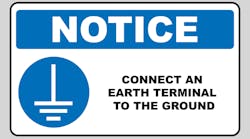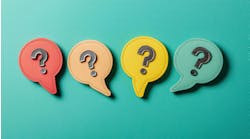If you work in plant maintenance, you probably don’t need to be concerned about grounding. Does that sound a bit inane? If so, let’s start by seeing what grounding is and why you use it.
If you read the Article 100 definition, you see it’s a connection to the earth. Literally, to the dirt. Because that’s what it is, it also cannot be a return path to the source. Remember the definition of a circuit: electricity flows from the source, to the load, and back to the source. Any simple circuit diagram, such as the classic battery powering a light, is a clear example of this.
Grounding (connection to earth) isn’t bonding (forming a low impedance path). If you compare the impedance of, say, 1,000 feet of earth to that of 1,000 feet of 4 AWG copper wire, you see a giant difference.
Now, recall Kirchhoff’s Law of parallel circuits. Electricity flows in inverse proportion to the impedances presented to it. A low impedance path such as that copper wire is going to carry practically all the undesirable current back to the source. But a high impedance path such as earth is going to carry a relatively small portion of the undesirable current back to the source. Most will flow through equipment, metallic objects, and people.
And if you apply Ohm’s Law, you understand that a higher impedance means a higher voltage across that impedance. That is, the voltage builds up just as water does behind a dam. If you ground instead of bond, you set the stage for voltage flashovers and other hazardous events.
Since the ground is not a return path for undesirable current, what is the purpose of having a ground (connection to earth)? Basically, lightning protection. That’s why we have system grounding, which is covered in Part III, Part VIII, and Part X of Article 250. And those connections are made at the supply (e.g., transformer).
Connecting to the grounding conductor
We don’t really “ground” equipment, even though equipment grounding is covered by Part VI and VII of Article 250. What is meant here is a connection to the equipment grounding conductor, which is really an equipment bonding conductor that eventually is connected at the ground connection to the power supply.
It may be tempting to think of the dividing line as inside the building versus outside the building, but that is not the case. For example, you can have a separately derived system inside the building. The dividing line is the line between the supply side and the load side of the source.
This means that on the supply side of the service, you’ll have a connection to the grounding electrode system [Part III of Article 250]. Or on the primary side of a transformer (separately derived source) you’ll have a ground connection, but not on the secondary side. For generators, the ground connection decision is a bit more complicated; be sure to review Article 445 carefully.
What if you ground on the load side? Wouldn’t it help with noise reduction and shock potential to tie each motor to a ground rod? To answer that question, think how the undesired current is going to get back to the source through that high impedance connection. The answer is it won’t help; it will waste money.
Now, picture a plant with a dozen motors, and each motor has a ground rod but there’s no bonding connection between those rods or between any motor and the equipment grounding (bonding) conductor. What is the impedance from one ground rod to the next, with dirt as the bonding conductor? Pretty high. This means you have significant differences of potential between various nodes of motor equipment and between each one and any other equipment.
Simply replacing those ground connections with bonding jumpers will put all that equipment at the same potential. This will likely solve “mysterious” power-quality problems and downtime gremlins. It will definitely make the plant safer for those who work there.




